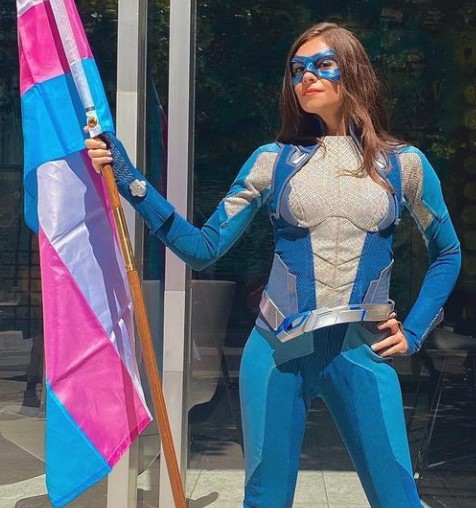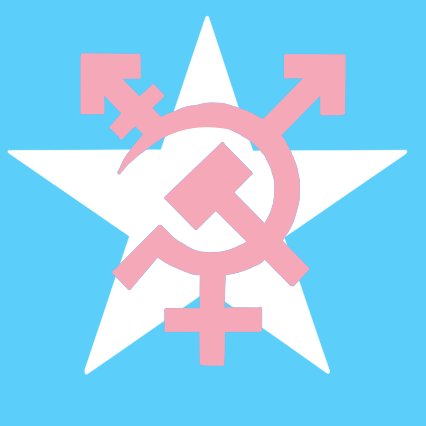A chairdre! This is a continuation of our discussion from the previous post: https://lemmygrad.ml/post/395378
Firstly, the link to the essay collection in question: https://transreads.org/wp-content/uploads/2021/07/2021-07-15_60f0b3d5edcb7_jules-joanne-gleeson-transgender-marxism-1.pdf
Today, I’ll be reading the first essay in the collection, Social Reproduction and Social Cognition: Theorizing (Trans)gender Identity Development in Community Context - Noah Zazanis
Noah Zazanis is a Marxist feminist, epidemiological researcher, and unrepentant transsexual. He lives in Queens and writes and organizes when he can.
I’ll pull some quotes and make some notes.
I hope that this will spark a discussion, or at the very least someone will have a chance to learn a little something <3
Edit 1: The discussion continues here with the second essay by Michelle O’Brien here - https://lemmygrad.ml/post/397671


From Marx’s Eighteenth Brumaire
“Men make their own history, but they do not make it as they please; they do not make it under self-selected circumstances, but under the circumstances existing already, given and transmitted from the past. The tradition of all dead generations weighs like a nightmare on the brains of the living.”
Following Marx, it can be understood that roles in society are a product of social reproduction, depending on reproductive labour to enforce and continue them. In this way, there is agency for those who participate in society. They may reproduce the roles and ideas of the past, or they may choose to step outside of those roles and work to undermine these concepts and strive for new understanding and new relations.
“In an article for Viewpoint Magazine, Fulvia Serra emphasises the importance of nurturance and emotional intimacy as modes of reproduction necessary for creating and sustaining revolutionary movements.”
Fulvia’s stance is that intimacy has been enclosed into households–we see this as true through our examinations of Fordian nuclear families, where communal identity is dissolved in favour of individualism. Liberal feminism, argues Fulvia, is primarily concerned with placing women into the roles of men in the workforce. We also see this with the classic “girlboss” narrative that liberal feminists push. That somehow there is a victory for women by having women participate in the same structures of exploitation as men.
However reproductive labour is still a necessary part of the reproduction of the workforce, and so capitalism steps into the gap and while elevating cis white women into the roles previously reserved for men and celebrating it as a progressive victory, marginalized women (usually migrant workers from exploited nations in the global south) are indentured into reproductive labour.
“Instead, citing Silvia Federici, Serra pushes for changes in the fundamental mode of reproduction through the collectivisation of care labour, so as to undo the ‘hierarchy and domination’ inherent in the division of reproductive labour across gendered lines.”
“trans people produce and reproduce our own identities, through our relationships and social spheres. While transition is often framed as a process of shifting encounters with cisgender expectations, [Gleeson] clarifies that it is equally a process of active community cultivation, and sustenance of trans identity. Through ‘support, mentoring, and reciprocal recognition’, as well as the curation and dissemination of ‘shared knowledge’ and ‘practical wisdom’, trans people ourselves facilitate the development of transgender identities in community with one another”
This is a framework of revolutionary modes of social reproduction. A communal effort for care that does away with the capitalist-enforced gender hierarchies that insist on reproductive care as an act of unpaid labour contained within individual nuclear families. We’ve all heard the phrase “it takes a village to raise a child” but the trans community has been keeping that adage alive in practical terms, crafting communities that foster social reproduction as a joint effort whereby care is a give and take and a shared burden.
This can be applied widely, where many of the symptoms of capitalist indoctrination are reproduced through closed-system families. This is one of the most powerful tools individualism has for its reproduction, for instance.
What follows is an explanation of Social Cognitive Theory. In SCT, gender identity is a lifelong formation, largely reproduced through “triadic reciprocal causation.” Basically, gender identity is formed (and reformed) through personal, behavioural and environmental factors.
In each person, the level to which these factors influence gender identity varies (the text gives the example that societies with very rigid gender roles will result in environmental factors playing a larger role in gender identity formation than personal factors. This tracks, as we see that in societies with less exposure to gender-nonconforming or societies that punish gender non-conforming harsher there is a more rigid and cisgender formation of identity).
Environmental influence is broken down into three main factors: modelling, enactive experience, and direct tuition.
Modelling: family, peers, media all show people models of what gender roles/identities should look like. For most people, your earliest models will be your direct family
Enactive experience: once you begin to perform your gender, the reactions you receive will help to shape your gender identity. For instance, a cis boy may wear makeup and be punished, teased, etc, and cease to wear makeup as he ages as a result. This is a form of enactive experience, where the constraints and performance of the role of man are shown to him through the negative responses he received to deviation from expected behaviours. This isn’t a trans thing: cisgender identity is largely a result of punishment for gender identity deviation. Boys are taught what is and isn’t manly. Girls are taught what is and isn’t feminine.
Cisgender norms are not a given: they are reinforced and reproduced. This isn’t necessarily always a conscious effort. Seeing your mom and thinking: “this is what it means to be a woman” is not the same as your mom punishing you for playing sports because that’s “boy behaviour.” Cisgender identities are cultivated and reproduced often without intent, whereby cis people tend to believe it is the “natural” or “inherent” set of gender roles.
In the same way, trans people (often before they are even aware of being trans) seek out and cultivate trans communities, where they are able to reproduce trans gender identities. These communities allow trans people to see models for gender roles that had previously been missing, to have enactive experiences that are affirming of deviation from cisgender norms rather than punitive.
This is why trans communities are an essential part of transition for many trans people. By being able to overcome the internalized normativity of cisgender identity roles, a belief that transition can be meaningful and actually affect their material reality is often integral to taking the step to realization of trans identity and a desire to pursue transition.
“For working-class trans people of colour, however, community identity development is most often necessarily inextricable from the reproduction of everyday life. Largely without the access to funding and medicalised legitimacy held by white-led NGOs, trans people of colour (particularly Black and Brown trans women) have developed extensive grassroots mutual aid networks and chosen familial structures”
While the self-efficacy of interaction with other trans people is often essential to the social reproduction of trans identities, this is leveraged by gender criticals as proof of “social contagion.” That people who had otherwise internalized cisgender identity roles would remain cisgender if they hadn’t been “turned” by other trans people.]
This has led to claims of “Rapid Onset Gender Dysphoria.”
However, if you consider the overwhelming amount of vectors for reproducing cisgenderism in children, and the acceptance of children who take on cisgender identity roles as authentic regardless of their age, this claim rings obviously false. The reproduction of cisgenderism is done through violence. The violence of the state, criminalizing trans women of colour, the violence of parents, punishing their children for deviation from cisgender identity norms, the violence of the medical establishment, reducing gender identity to a function of genitalia.
Alright, this was a pretty good essay. Gonna take a break before tucking into the next one. Thank you for joining me, if you have <3
I’ll leave off with this final quote:
“Trans people are not distinguished by our victimhood. It is in cases of cisgender identification that this coercion has been most effective.”
deleted by creator